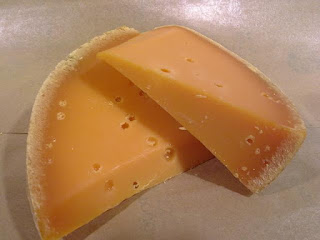Today I had the pleasure of hosting a wine and cheese pairing event and was pleasantly surprised to have so many people attend! I figured that since there were so many people, I'm sure that I wasn't able to explain all of the cheeses to everyone in detail. So I'll go into detail regarding the pairings here and you can impress your guests this holiday with these tasty pairings. We'll start from the beginning...
Here is a picture of all of the cheeses I served today. We'll start with the white cheese on the bottom left and work our way around clockwise. The first two cheeses I paired with the Serenity from Brassfield Estate Winery (56% Pinot Grigio, 31% Sauvignon Blanc, 13% Gewurztraminer).
I was stumped for a while about what cheese to pair with it because of the blend. Gewurztraminers normally pair with bigger cheeses like blue cheese. But the Pinot Grigio and Sauvignon Blanc grapes added slight citrus notes and well as a dry finish, so blue cheese didn't work very well. I eventually found some very tasty pairings and will describe them below.
The first cheese is the Capricho de Cabra (or Capricho for short) from Murcia, Spain. I like to introduce this cheese to any person who either has never had goat cheese or someone who says that they don't like goat cheese. It is comparable to a fresh chevre; super creamy and mild with a very clean finish. The milk for this cheese is from the Murcian goats which are known for having sweeter milk. By having sweeter milk you're able to tame the gamey goat flavor. Thus allowing people who think they don't like goat cheese to fall in love with this one. The pairing of the Capricho and the Serenity was a very clean pairing. The goat's milk just sang along side the Sauvignon Blanc grapes, had a slight lemony flavor to play nicely with the Pinot Grigio grapes and just enough sweetness to pair with the Gewurztraminers. Quite a delightful pairing!
The second cheese that I paired with the Serenity was the Cremont from Vermont Butter and Cheese Creamery. This cheese I actually featured on my first post of this blog. It is a soft ripened goat and cow's milk cheese that is definitely one of my favorites. By having both cow and goat's milk I thought this pairing was even better than the first. The cheese itself is quite tangy from the goat's milk, but the wine really mellows out the tang. The cow's milk and its decadent creaminess really works with the sweeter grapes of the Gewurztraminer and Pinot Grigio while the goat's milk is a perfect partner for the Sauvignon Blanc grapes. As I was serving this pairing today I used the phrase "food-gasm" more than once. You just have to try it to understand what I'm talking about.

Now onto the last two cheeses and the Eruption, also from Brassfield Estate Winery. The Eruption is quite a blend - 22% Syrah, 21% Tempranillo, 15% Malbec, 14% Grenache, 12% Mourvedre, 8% Petite Sirah and 8% Zinfandel. Pretty intense right? The wine itself is slightly tannic but is balanced out with a slight jamminess. Basically, every flavor that I like from red wines are combined into this wine. And things just get better when the cheeses are introduced.
The first cheese I paired with the Eruption is the Cantal from Auvergne region in France. Ironically this region in France is known for its many volcanos making the pastures extremely fertile. I thought this was a fun fact since the wine is called Eruption :). The Cantal itself is a raw milk cheese that has been aged for 2 - 6 months (at least the Cantal that we sell). It is a semi-firm cheese that has a wonderfully creaminess to it as well as a slightly tangy finish. The natural rind that is allowed to form on the outside of the cheese as it ages also lends a slighty earthy, almost dusty flavor. The cheese is so balanced that it works nicely with the many grapes used in the wine. It seemed out of all the cheeses, this was the most popular of the bunch.
The last cheese is my absolute favorite blue cheese in the whole wide world... Rogue River Blue. This blue cheese is made by Rogue Creamery in Oregon. It is wrapped in Syrah leaves that have been soaked in pear brandy, is made with raw cow's milk and is aged for a minimum of 9 months. At the 2009 and 2011 American Cheese Society conferences it won Best in Show and really lives up to these awards. The Rogue River Blue is so complex yet beautifully balanced. It has a nice creaminess with a touch of salt, a hint of spice, a little bit of fruit from the brandy and an earthiness lent to it by the Syrah leaves and the act of aging this cheese in a cave. Now, if you thought the last three pairings were good, wait til you try this one! I couldn't believe how well this cheese worked with the Eruption. Both the wine and cheese have such unique, complex flavors that it's amazing how wonderfully they work together. It's almost too hard for me to describe how they taste. They combine to create a salty sweet flavor that is absolutely stunning. If you ever try a cheese and wine pairing, make sure that you try this one.
Well, that was a long-winded post. I hope this gives you enough insight to impress your friends with these great pairings and be the host/hostess of the year. As always, you are more than welcome to come by the cheese counter and try any of the cheeses listed above. I wish you all a Merry Christmas and I hope to see you soon! Until then, eat, drink and be happy!































